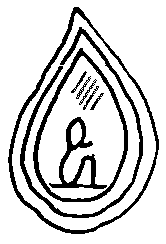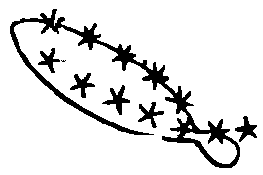
Sacred Texts Ancient Near East Index Previous


The Babylonian Legends of Creation, by E. A. Wallis Budge, [1921], at sacred-texts.com
1 See the Transactions, Vol. IV, Plates I-VI, London, 1876.
2 See the duplicate fragments described in the Index to Ebeling, Keilschrifttexte aus Assur, Leipzig, 1919 fol.
3 The text is found on a tablet from Abû Habbah, Brit. Mus., No. 93,014 (82-5-22, 1048).
4 APSÛ. It is doubtful if APSÛ here really means the great abyss of waters from out of which the world was called. It was, more probably, a ceremonial object used in the cult of the god, something like the great basin, or "sea," in the court of the temple of King Solomon, mentioned in I Kings, vii, 23; 2 Kings, xxv, 13, etc.
5 This is a name under which Marduk was worshipped at Eridu.
6 The god whose head was taken off was not Belus, as is commonly thought, but the god who the cuneiform texts tell us was called "Kingu."
7 The god whose head was taken off was not Belus, as is commonly thought, but the god who the cuneiform texts tell us was called "Kingu."
8 Muallidat gimrishun
 .
.
9 It is probable that the idea of this Tablet is perpetuated in the "Preserved Tablet" of the Ḳur'ân (Surah x, 62), on which the destiny of every man was written at or before the creation of the world. Nothing that is written (maktûb) there can be erased, or altered, or fail to take effect.
10
 (Cun. Texts, Part XXIV, Plate 44, l. 142).
(Cun. Texts, Part XXIV, Plate 44, l. 142).
 |
 |
 and two drawings of it are extant. The first shows an oval object rimmed with stars and the other a pear-shaped object, with a god inside it. (See Brugsch, Inschriften (Astronomische) Leipzig, 1883, p, 146.)
and two drawings of it are extant. The first shows an oval object rimmed with stars and the other a pear-shaped object, with a god inside it. (See Brugsch, Inschriften (Astronomische) Leipzig, 1883, p, 146.)
12 This is the original of the Syriac word for the Signs of the Zodiac malwâshê (plural of malwâshâ). The Syrians added to it an m, thus giving it a participial form.
13 Δεκανοί also called πρόσωπα, ὡροσκόποι, φύλακες and ἐπίσκοποι. They were well known to the Egyptians, who, as early as the fourteenth century B.C., possessed a full list of them. See Lepsius, Chronologie, Berlin, 1848, and Brugsch, Thesaurus (Astronomische und Astrologische Inschriften), Leipzig, 1883.
14 Formerly known as Ninip.
15 See Naville, La Litanie du Soleil, Paris, 1875, Plate ii ff.
16 See Kur'ân, Surah vii, v. 179. That there were ninety-nine Beautiful Names of God rests on the authority of Abû Hurairah, who repeats the statement as made by Muhammad the Prophet.
17 Published by King, Cuneiform Texts, Part XXV, Plate 50.
18 Thus he is equated with En-Urta, Nergal, En-lil, Nabû, Sin, Shamash, Adad, etc.
19 See Poebel, Historical Texts, No. 1.
20 See King, Cuneiform Texts, Part XIII, Plate 33; and Ebellog, Assurtexte, I, No. 6.
21 The biru was the distance which a man would travel in two hours.
22 This translation is made from transcripts of the British Museum fragments (Cuneiform Texts, Part XIII), and transcripts of the Berlin fragments (Ebeling, Keilschrifttexte aus Assur, Nos. 117, 118).
23 The name of an object was the object itself, and it was believed that nothing could exist apart from its name.
24 Tiâmat's wrath was roused by Apsu, who had proposed to slay the gods, her children. She took no part in the first struggle of Apsu and Mummu against the gods, and only engaged in active hostilities to avenge Apsu.
25 Literally, "they excited themselves to hostility."
26 A title of Tiâmat.
27 These nine monsters with the Weapon (Thunderbolt?) and Kingu form the Eleven Allies of Tiâmat, and it is clear that she and her Allies represent the Twelve Signs of the Zodiac. When Marduk destroyed Tiâmat and her associates, he found it necessary to fix the stars, the images of the great gods, in their places, as the Twelve Signs of the Zodiac. (See the Fifth Tablet of Creation, p. 55.)
28 The god here alluded to is Mardak, who, in one aspect, is a fire-god; see Tablet IV, II. 39, 40.
29 See above.
30 Lines 83, 84, 88-101 are translated from the British Museum fragments and the Berlin fragments; lines 88-101 contain the equivalent to the whole gap in the British Museum tablet.
31 i.e., "let what thou sayest prevail."
32 I.e., the destruction of Tiâmat.
33 I.e., the establishing of a new creation to take the place of the old.
34 The meaning of
 pal-a is unknown.
pal-a is unknown.
35 This equipment of the charioteer is shown on the bas-reliefs.
36 Compare Psalms xviii, 7-15; civ, i ff.
37 I.e., the gods were impatient to begin the fight.
38 By impressing his seal on the Tablet Marduk proved his ownership of the Tablet, and made his claim to it legal.
39 This is an oblique way of saying that Marduk succeeded where Ea failed.
40 The word is kupu, i.e., "reed" or "sedge." It is possible that Marduk skinned Tiâmat.
41 Reading, ishtenish lu kuppudu-ma ana shina lu uzizu.
42 I.e., "to cause the gods to be content,"
43 Literally "they (indefinite) opposed me."
44 See Cuneiform Texts, Part XXIV, Plate 50, where it is said that the god Sin is "Marduk, who maketh bright the night."
45 Lines 44 and 45 announce Marduk's determination to build Babylon.
46 This is the word commonly used for "temple-tower." The famous ziggurat of E-Sagila here mentioned was built in Seven Stages or Steps, each probably having its own distinctive colour. It was destroyed probably soon after the capture of Babylon by Cyrus (539 B.C.) and when Alexander the Great reached Babylon he found it ruins.
47 This is the first known mention of the "horns" of a ziggurat, and the exact meaning of the word is doubtful.
48 From this text it seems clear that Up-shukkinaku was the name of a chamber in the temple of E-Sagila. This name probably means the "chamber of the shakkanaku," i.e., the chamber in which the governor of the city (shakkanaku) went annually to embrace the hands of the god Bel-Marduk, from whom he thereby received the right of sovereignty over the country.
49 This line seems to imply that Marduk was regarded as the instructor of the "old" gods; the allusion is, probably, to the "ways" of Anu, Bel and Ea, which are treated as technical terms in astrology.
50 Here the title "Black-headed" refers to all mankind, but it is sometimes used by the scribes to distinguish the population of the Euphrates Valley from foreign peoples of light complexions.
51 Compare the language of the Kur'ân (Surah II, v. 256), "He (Allah) knoweth what is before them and what is behind them."
52 These lines suggest that the fight between Marduk and Tiâmat was recurrent; it is incorrect to translate the verbal forms as preterites.
53 "To open the ears" -- to give understanding.
54 The Egyptian Sheta
